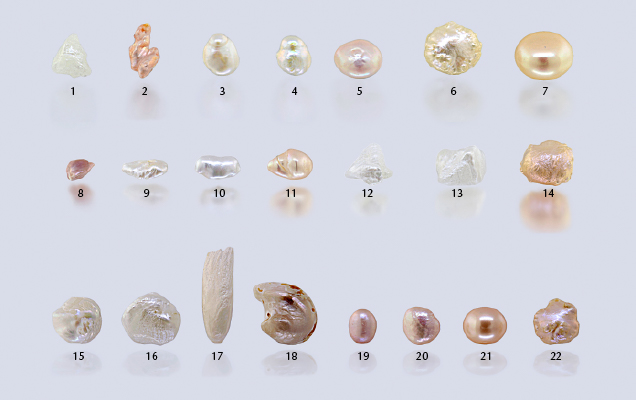DNA Barcoding and Next-Generation Sequencing (NGS) of Freshwater Pearls

Research efforts on the deoxyribonucleic acid (DNA) species identification of biogenic materials, in particular pearls, have been the focus of some gemological laboratories, including GIA’s, for several years (J.B. Meyer et al., “DNA fingerprinting of pearls to determine their origins,” PLOS ONE, Vol. 8, No. 10, 2013, e75606; K. Saruwatari et al., “DNA techniques applied to the identification of Pinctada fucata pearls from Uwajima, Ehime Prefecture, Japan,” Spring 2018 G&G, pp. 40–50; K. Scarratt, CIBJO Special Pearl Report, 2019). Here we report on the findings of a study on the DNA analysis of cultured and natural freshwater pearls originating from both North America and China using the next-generation sequencing (NGS) technique, in collaboration with the Canadian Centre for DNA Barcoding at the University of Guelph.
A total of 22 freshwater pearl samples were subjected to DNA barcode analysis (see above). Nine American freshwater natural pearls (sample numbers 1, 2, 8, 12, 13, 15, 16, 17, and 18) and four American freshwater cultured pearls (sample numbers 3, 4, 9, and 10) from Gina Latendresse (American Pearl Company, Inc., Nashville, Tennessee), and nine Chinese freshwater cultured pearls (sample numbers 5, 6, 7, 11, 14, 19, 20, 21, and 22) from the GIA research collection were analyzed. The samples were either drilled with a hand drill using sterile techniques or crushed with a mortar and pestle using liquid nitrogen to obtain powder for analysis. Previously published DNA extraction protocols for pearls were modified to include newly designed primers for polymerase chain reaction (PCR) amplification and NGS. Only high-quality reads assigned to correct Ion Xpress MID (molecular identifier) tags were used in NGS data analysis. Negative PCR and negative extraction controls did not produce any valid sequencing data. Blast algorithms were utilized to match resulting operational taxonomic units to a reference library database for mitochondrial cytochrome c oxidase subunit I; results were imaged using MEGAN software. DNA sequences recovered from the unknown pearl samples were compared against the species sequence reference library in the Barcode of Life Data System, accessible at http://www.boldsystems.org, and compared against the National Center for Biotechnology Information database (https://www.ncbi.nlm.nih.gov).

DNA fragments from eight of the twenty-two samples were successfully recovered and identified. DNA-based species identification was highly consistent with the reported origin of the pearls (table 1). Results on the analyses of the 14 remaining samples were not successful, and no valid yield was recovered. This can be attributed to many factors, including insufficient DNA content due to limited sample size, or the elimination of trace DNA during the various routine pearl treatments known to be applied. While challenges remain on the extraction of DNA fragments from pearls, the results indicate that this technique can provide positive matches on individual pearls and prove which mollusk species they originated from, thus aiding in the identification of some challenging pearls or confirming mollusk origins in cases where greater detail may justify the time and expense of such analyses.
This joint research was previously presented at the 7th International Barcode of Life Conference (Genome, Vol. 60, No. 11, pp. 1003–1004). GIA will continue to investigate this field of research, which is proving to be a highly valuable supplementary technique in the gemological examination of pearls.



